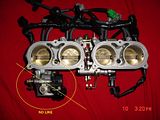this thread is for those that removed the exup valve from their bike (for whatever reason) and ,are stuck with the exup motor connected to the wiring harness and doing nothing .
the exup motor weights a bit more then 300gr , disconnecting the motor will cause error codes on the speedo cluster .
it took me some time to test various circuits ,and find the easiest way to eliminate the EXUP errors , so basically ,anyone can make it.
for those that dont know this allready , there are commercial units available , but they cost "a bit" more then the circuits described here
as far as i know , the EXUP works the same way for all yamaha bikes (all R1s , WR ,VMAX etc...) so the same tricks described here ,can be used on all yamaha bikes.
the only difference is the color of the wires connected , in this thread i will only discuss 98-08 R1s (the 09 R1 got no exup) ..
the exup motor weights a bit more then 300gr , disconnecting the motor will cause error codes on the speedo cluster .
it took me some time to test various circuits ,and find the easiest way to eliminate the EXUP errors , so basically ,anyone can make it.
for those that dont know this allready , there are commercial units available , but they cost "a bit" more then the circuits described here
as far as i know , the EXUP works the same way for all yamaha bikes (all R1s , WR ,VMAX etc...) so the same tricks described here ,can be used on all yamaha bikes.
the only difference is the color of the wires connected , in this thread i will only discuss 98-08 R1s (the 09 R1 got no exup) ..














